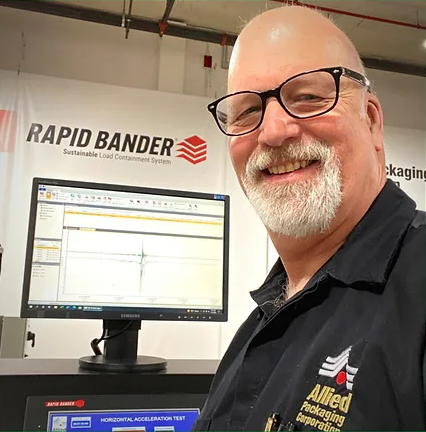Ask Steve
June 22, 2023
Question from Ted: We have stretch wrap machines, but I really don’t understand how they work. Can you explain the basic function and what adjustments can be made?
Hi Ted, thanks for a really great question. I have talked at length about stretch film and the physics of load containment, but have not really focused on the stretch wrap machine itself, which is an integral part of the process.
There are several types of machines in use, but they all have some basic elements in common.
There are rotary table machines, where the load is placed on a table which rotates as the film is applied. Some variations have conveyors which deliver the pallet to the wrapper and remove it after the cycle. These machines are generally used in lower volume applications. One reason is that since the pallet is turning, higher the rotation speeds needed to support higher production rates can cause the contents of unstable loads to become projectiles due to centrifugal force, which becomes greater as table speeds increase.
The next type is a rotary arm machine where the pallet is located, either by forklift or conveyor in the center of the wrapping area as an arm rotates around the stationary pallet. This type of machine generally serves higher volume applications.
The third is referred to as a ring wrapper where the pallet is delivered to the wrapper and removed on a conveyor. A ring encircles the pallet and has one or two film carriages, which rotate on the ring at high speeds while the ring moves vertically during the wrap cycle. These are fully automatic, more complex, machines wrapping at higher speeds, and only used in very high-volume applications.
Now that we understand the different methods used to create rotation around the pallet, you can see they all provide the first basic function of the wrapper, and that is to apply film evenly to every side of the load.
Now let’s turn our focus to the film delivery system, commonly referred to as the film carriage. This component of the machine has provisions to hold the roll(s) of film and to pre-stretch it to some percentage before it is applied to the load. It travels the height of the load vertically (either on the tower of the table machines, the arm of the rotary arm machine, or on the ring of a ring machine) dispensing film and providing complete coverage to the load. There are typically 2 driven rollers, called pre-stretch rollers, one infeed and one outfeed. Idler rollers press the stretch film to the pre-stretch rollers. There is a speed difference between the pre-stretch rollers, which is accomplished either through a gear ratio tying the rollers together, or a difference in roller diameters. The outfeed roller turns faster than the infeed roller, causing the film to be stretched (by the percentage of the speed differential). When you hear the term pre-stretch, this is how it is done. I have discussed the importance that Total Applied Stretch has on load containment. It has two components, one pre-stretch which we just covered, next is Applied Tension the second critical element of load containment. Just as the film is stretched in pre-stretch by the difference in the speed of the infeed and outfeed rollers, the film is again stretched based on the higher rotation speed of the load compared to the speed the pre-stretch rollers dispense the film. The greater the difference in speed, the more tension is applied and the more the film is stretched. An interesting side note, unless the load is perfectly round and placed exactly in the center of the wrap area, there will be variation in the distance between the carriage and the load during rotation. To compensate for that, the rate film is dispensed varies as the corners of the load are reached, maintaining a consistent tension between the carriage and the load. The film is dispensed more slowly as you reach a corner, then faster once the corner has passed. This is the same principle used by your car’s cruise controls, which vary the amount of engine power when traveling up and down hill on the highway to maintain the same speed.
Now that you understand how the machine works, let’s dive into the primary adjustments you can make to improve load containment.
Pre-Stretch: Some machines have adjustable pre-stretch, but they are few and far between. Most have sprockets of different diameters on each of the pre-stretch rollers with a chain or belt connecting them. If you want to change pre-stretch, then the sprockets need to be changed to achieve the ration or pre-stretch you want or need.
Tension: Tension adjustment is normally a dial or entry on an HMI and expressed in a % of the maximum tension the machine can apply. So, if a dial has marks from 1-10, and you have it set on 4.5, it will be 45% of the machine’s maximum tension. The HMI values are usually expressed in direct percentage, so 45 is 45%.
Carriage Speed: Most machines allow you to set the carriage speed independently for travel up and travel down. This can be handy because in some cases you may want the carriage to travel faster up and slower down (or vice versa). For machines that have HMIs, you may not be able to adjust the speed of the carriage but will instead enter the overlap from one layer of film to the next. For example, increasing film overlap decreases carriage speed. Carriage Speed (or Film Overlap) dictates the number of wraps applied to the load.
Extra Wraps (Top and Bottom): You will find the need to add an extra wrap or more at the top and/or at the bottom of the load. This control allows you to increase containment at the top and the bottom of the load.
Wrap Speed:If you increase wrap speed on a machine where carriage speed can be set, you reduce the number of wraps, conversely, reducing speed will increase the number of wraps. If your machine has an HMI and you enter film overlap, wrap speed will not affect the number of wraps.
I know there is a lot to unpack here (pun intended). I think it is important for you to understand, in general terms, how the equipment works and the type of adjustments that can be made. But don’t feel that you have to tackle this complex system yourself. Our Field Service Engineers are experts, they know this equipment inside and out, they also understand load containment. We can optimize your system for load containment and film usage. However, we do not stop there, we will periodically audit the stretch wrap process to ensure your long-term success, and in addition, provide maintenance as required, so you have one less thing on your plate to worry about.
Thanks for asking!








